This section displays herbicide injury symptoms based on the
mode of action of the herbicide, e.g. 2,4-D is in the Growth
Regulator family.
Select the "Classified by Herbicide Active Ingredient"
link to view the section on herbicide injury symptoms based on
the common name (active ingredient) of the herbicide. Most herbicide
products will list the common name under the active ingredient
section of the label. A cross reference list of trade names and
common names can also be found in Weed
Control Guidelines for Indiana WS-16.
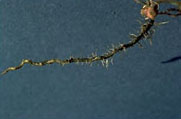 |
CORN
Mode: Amino Acid Synthesis Inhibitor
Herbicide: Chlorimuron
Injury: Short "Bottle-Brush" Lateral Roots (Imazaquin
can also display similar symptoms under different conditions)
Condition: Carryover of herbicide due mostly to high soil
pH (>6.8)
|
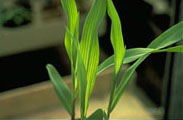 |
CORN
Mode: Amino Acid Synthesis Inhibitor
Herbicide: Chlorimuron
Injury: Interveinal Chlorosis (Imazaquin can also display
similar symptoms under different conditions)
Condition: Carryover of herbicide due mostly to high soil
pH (>6.8)
|
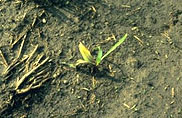 |
CORN
Mode: Amino Acid Synthesis Inhibitor
Herbicide: Chlorimuron
Injury: Stunting of Plant (Imazaquin can also display
similar symptoms under different conditions)
Condition: Carryover of herbicide due mostly to high soil
pH (>6.8)
|
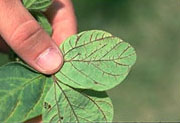 |
SOYBEAN
Mode: Amino Acid Synthesis Inhibitor
Herbicide: Chlorimuron
Injury: Red Leaf Veins (Imazethapyr and Thifensulfuron
can also display similar symptoms)
Condition: Postemergence application made on days with
high temperatures and humidity; misapplication
|
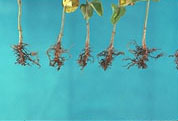 |
SOYBEAN
Mode: Amino Acid Synthesis Inhibitor
Herbicide: Chlorimuron
Injury: Reduced Root System
Condition: An extended period of wet conditions following
a soil application of the herbicide and planting of the crop
|
 |
CORN
Mode: Amino Acid Synthesis Inhibitor
Herbicide: Imazaquin
Injury: Short "Bottle-Brush" Lateral Roots (Chlorimuron
can also display similar symptoms under different conditions)
Condition: Carryover of herbicide to corn due mostly to
lack of moisture for adequate herbicide breakdown; secondary
- very low soil pH, soils high in clay and organic matter content
|
 |
CORN
Mode: Amino Acid Synthesis Inhibitor
Herbicide: Imazaquin
Injury: Interveinal Chlorosis (Chlorimuron can also display
similar symptoms under different conditions)
Condition: Carryover of herbicide to corn due mostly to
lack of moisture for adequate herbicide breakdown; secondary
- very low soil pH, soils high in clay and organic matter content
|
 |
CORN
Mode: Amino Acid Synthesis Inhibitor
Herbicide: Imazaquin
Injury: Stunting of Plant (Chlorimuron can also display
similar symptoms under different conditions)
Condition: Carryover of herbicide to corn due mostly to
lack of moisture for adequate herbicide breakdown; secondary
- very low soil pH, soils high in clay and organic matter content
|
 |
SOYBEAN
Mode: Amino Acid Synthesis Inhibitor
Herbicide: Imazethapyr, Thifensulfuron
Injury: Red Leaf Veins (Chlorimuron can also display similar
symptoms)
Condition: Postemergence application made on days with
high temperatures and humidity; misapplication
|
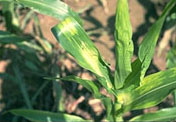 |
CORN
Mode: Amino Acid Synthesis Inhibitor
Herbicide: Nicosulfuron, Primisulfuron
Injury: Yellowing of whorl, chlorotic patches across leaf,
stunting of shoot; malformed leaves
Condition: Postemergence herbicide applied during high
temps and humidity, during stressed conditions (drought, compaction,
etc.) or following the application of an organo-phosphate soil
insecticide
|
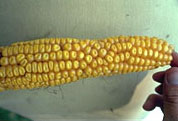 |
CORN
Mode: Amino Acid Synthesis Inhibitor
Herbicide: Nicosulfuron, Primisulfuron
Injury: Reduction in kernel rows from butt to tip of ear
Condition: Late postemergence herbicide applications where
most of the corn leaves and whorl intercept the herbicide
|
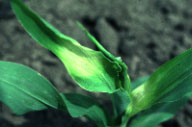 |
CORN
Mode: Amino Acid Synthesis Inhibitor
Herbicide: Glyphosate
Injury: Bleached-white appearance of whorl or patches
across leaf
Condition: Drift of herbicide; symptom expressed dependent
on degree of drift
|